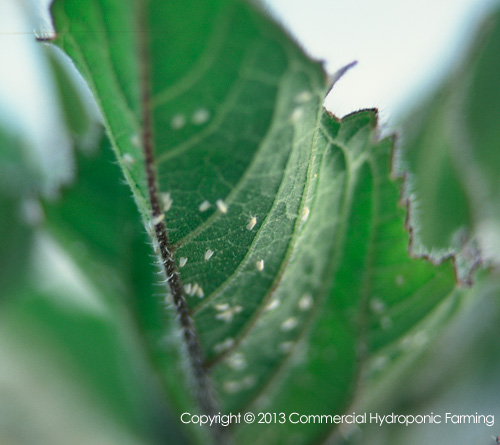Greenhouse white fly
Description
Greenhouse white fly, also known as Trialeurodes vaporariorum is a sap feeder. The easiest way to find white flies is to brush or shake the leaves and look for the white fly adults which fly off. Inspect the undersides of the leaves for the flies. These pets are important vectors of diseases which are often more devastating than the injury caused by their feeding. One important diseases is the leaf curl virus.
Damage
White fly cause significant damage to leaves by inserting their piercing-sucking mouth parts into the epidermis to reach the phloem. This leaves a hole in the epidermis through which bacteria and viruses can enter. Because the sap is sucked out, the leaf turns yellow and sections can die, reducing the leaves effectiveness to photosynthesize.
The destructive power of white flies are their ability to transmit or spread plant pathogens, especially viruses and the production of honeydew or sooty mold. While feeding, white flies excrete a sticky, sugary substance called honeydew. This substance coat leaves and stems, creating an ideal environment for the growth of sooty mold. The mold does nothing to the plant itself, but it blocks sunlight reducing or lowering the photosynthetic rate.
Transmission of Plant Viruses is the most devastating effect of white flies. Greenhouse white flies transmit several plant viruses, of which the genus Begomovirus (e.g., Tomato yellow leaf curl virus, Cucumber mosaic virus) are very destructive. These viruses reduce yields by inducing symptoms such as leaf curling, yellowing, mottling, and deformation of fruits. When young fruit are punctured at an early stage, the mature fruit show small dark spots or lesions that reduce the quality of the fruit. Usually these fruit have to be down graded and the growers margin is reduced.
Virus Spread: Once a white fly acquires a virus, it can transmit it to multiple plants as it moves and feeds, leading to rapid spread of the disease within a greenhouse or garden.
Control
• Monitor: yellow sticky traps
• Chemical: be very careful with chemical control. Due to the short life cycle of white flies, their ability to develop chemical resistant is very high. I know of farmers that have no control due to resistance.
Life stages of the greenhouse white fly:
Egg Stage: The Female white fly lay tiny, oval-shaped eggs on the underside of leaves, which are very difficult to detect. Up to 200 eggs can be deposited during the females lifespan. Considering how rapid white flies propagate, this is significant. The eggs are initially pale yellow but darken as they develop. This stage lasts about 7 to 10 days, depending on environmental conditions, particularly temperature.
Nymph (Crawler) Stage: Once the eggs hatch, the young nymphs or called crawlers move rapidly to feed on young leaves. Damage on the leaves are caused by inserting their mouth parts into the plant tissue after which they remain stationary, feeding on the plant sap. The nymph stage has four instars (developmental stages), with the first instar being the mobile crawler and the subsequent instars being sedentary. This stage lasts about 2 to 4 weeks, depending on temperature.
Pupal Stage: The final instar is the pupal stage. The nymph develops into an adult inside a stationary, oval, and flattened structure found on the underside of leaves and is covered with a waxy secretion. Again not easy to spot and scouters must be trained to look for the culprit. This stage lasts between 60-10 days.
Adult Stage: The adult white fly emerges from the pupal case. Adult white flies are small, about 1-2 mm long, with white, powdery wings and yellowish bodies. They begin to feed on plant sap immediately and can start laying eggs within a few days. Adult white flies live for about 1 to 2 months, during which they continue to reproduce, leading to overlapping generations.
Share This Story, Choose Your Platform!
Cotton aphid – Aphis gossypii
Cotton Aphid, or Aphis gossypii, is one of the more common insect pests found in almost all vegetable crops and [...]
Greenhouse white fly
Description Greenhouse white fly, also known as Trialeurodes vaporariorum is a sap feeder. The easiest way to find white flies [...]







